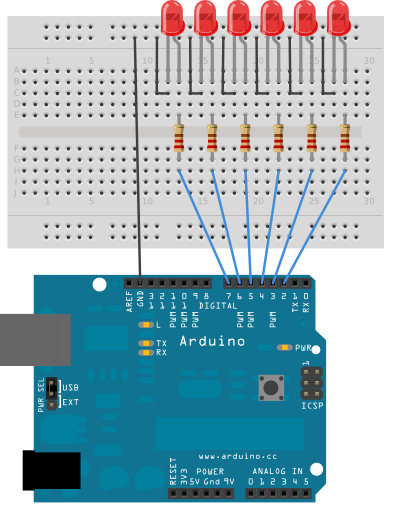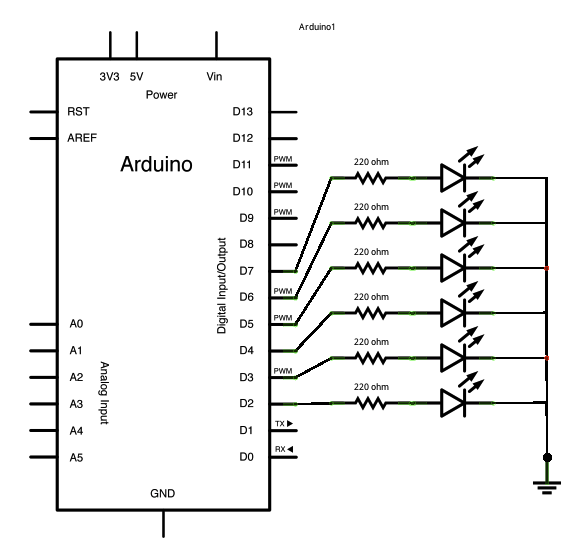Often you want to iterate over a series of pins and do something to each one. For instance, this example blinks 6 LEDsattached to the Arduino or Genuino by using a for() loop to cycle back and forth through digital pins 2-7. The LEDS are turned on and off, in sequence, by using both the digitalWrite() and delay() functions .
We also call this example "Knight Rider" in memory of a TV-series from the 80's where David Hasselhoff had an AI machine named KITT driving his Pontiac. The car had been augmented with plenty of LEDs in all possible sizes performing flashy effects. In particular, it had a display that scanned back and forth across a line, as shown in this exciting fight between KITT and KARR. This example duplicates the KITT display.
Hardware Required
- Arduino or Genuino Board
- 6 220 ohm resistors
- 6 LEDs
- hook-up wires
- breadboard
Circuit
Connect six LEDS, with 220 ohm resistors in series, to digital pins 2-7 on your Arduino.
click the image to enlarge
Schematic:
click the image to enlarge
Code
The code below begins by utilizing a for() loop to assign digital pins 2-7 as outputs for the 6 LEDs used.
In the main loop of the code, two for() loops are used to loop incrementally, stepping through the LEDs, one by one, from pin 2 to pin seven. Once pin 7 is lit, the process reverses, stepping back down through each LED.
/*
For Loop Iteration
Demonstrates the use of a for() loop.
Lights multiple LEDs in sequence, then in reverse.
The circuit:
* LEDs from pins 2 through 7 to ground
created 2006
by David A. Mellis
modified 30 Aug 2011
by Tom Igoe
This example code is in the public domain.
http://www.arduino.cc/en/Tutorial/ForLoop
*/
int timer = 100; // The higher the number, the slower the timing.
void setup()
{
// use a for loop to initialize each pin as an output:
for (int thisPin = 2; thisPin < 8; thisPin++)
{
pinMode(thisPin, OUTPUT);
}
}
void loop()
{
// loop from the lowest pin to the highest:
for (int thisPin = 2; thisPin < 8; thisPin++)
{
// turn the pin on:
digitalWrite(thisPin, HIGH);
delay(timer);
// turn the pin off:
digitalWrite(thisPin, LOW);
}
// loop from the highest pin to the lowest:
for (int thisPin = 7; thisPin >= 2; thisPin--)
{
// turn the pin on:
digitalWrite(thisPin, HIGH);
delay(timer);
// turn the pin off:
digitalWrite(thisPin, LOW);
}
}

